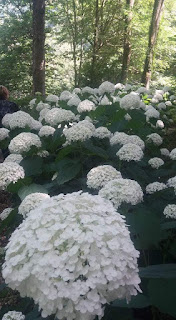Hydrangea arborescens Annabelle
La prima volta che ho visto dal vivo l'Hydrangea arborescens Annabelle è stato un anno fa durante la visita alla collezione di ortensie di Villa Piaggio (Masone) guidata dalla bravissima Eva Boasso. Una lunga siepe, che nella penombra di una valletta appariva ancora più bianca, quasi accesa da una luce fatata che sembrava irradiare dalle grandi infiorescenze globose.
Annabelle a Villa Piaggio
Inutile dire che è stato amore a prima vista, anche mio marito, normalmente immune ai colpi di fulmine floreali ne è rimasto colpito...questo è dir tutto!
Come tutte le Hydrangee appartenenti alla specie arborescens, Annabelle è originaria del nord-america. Fu rinvenuta da J. C. MaDaniel nel 1910 nello stato dell'Indiana, nei pressi della cittadina chiamata Anna. Introdotta in Europa neglia anni '20, riscosse subito un enorme successo, specialmente in Inghilterra e Francia. La scrittrice Virginia Woolf e il marito Leonard ne furono affascinati e la impiantarono nel loro bel giardino del Sussex dove ancora oggi fa bella mostra di sè.
La siepe di Annabelle presso il vivaio "I giardini e le fronde"
A inizio primavera, le infiorescenze si presentano di un bel verde mela che contrasta con il verde appena più scuro delle foglie a forma di cuore, tipiche della specie. Man mano che la stagione avanza, il verde lascia campo ad un bianco intenso che poi, magia della natura, torna nuovamente verde. La posizione ideale di Annabelle è la mezz'ombra che fa risaltare ancora di più i suoi colori, accesi magicamente anche dall'imbrunire, ma a differenza delle altre ortensie bianche, sopporta bene anche posizioni soleggiate.
Le Annabelle di Lucia (I giardini e le fronde)
Dato che questa specie tollera bene i terreni poveri ho deciso di provare a impiantarla in una delle fasce a margine del bosco, appena sopra le rose. Mi sono presa il tempo di una stagione per verificare se è la posizione giusta per lei prima di acquistarne almeno altre 2 piante e provare a realizzare una siepe. Tra l'altro le arborescens sono buone colonizzatrici perchè pollonano molto dalla base e si moltiplicano anche radicando dai rami laterali interrati, quindi in poco tempo predono possesso degli spazi a loro assegnati. Non è necessario comprare molte piante per un buon risultato, perchè la natura farà da sè.
Oltre ad Annabelle ho acquistato Incrediball, creata nel 2011 come "potenziamento" della sua genitrice, nel senso che le infiorescenze sono più grandi e si ergono meglio sugli steli più resistenti.
La mia Incrediball
La potatura delle ortensie è spesso problematica perchè alcune varietà fioriscono sui rami vecchi, quindi tagliandoli drasticamente si rischia di compromettere la fioritura successiva. Con le arborescens è tutto più semplice perchè fioriscono sui nuovi rami, quindi anche una potatura drastica a fine inverno non ci priverà della magica fioritura delle nostre hydrangee fatate.
Sorpresa delle sorprese, proprio ieri, seguendo @GardenAnswer della bravissima Laura LeBoutillier, ho scoperto l'esistenza di Hydrangea arborescens Invincibelle che altro non è se non la versione rosa di Annabelle. Molto bella vero? Cosa ne pensate? Annabelle o Invincibelle? Lasciatemi un commento e fatemi sapere quale preferite!
Per acquistare ottimi esemplari di Hydrangee vi consiglio una visita a I giardini e le Fronde, Via Fabbriche 75, Serravalle Scrivia, Al
http://www.igiardinielefronde.it/
Se conoscete l'inglese, seguite gli ottimi consigli di Laura LeBoutillier sui social e su Youtube @GardenAnswer
💛💜💚❤️💙
Hydrangea arborescens Annabelle is a fairy beauty that I first met a year ago. I immedialtelly fell in love with its huge white flowers that magically shine in the shade and at dusk. It was discovered in 1910 by J.C. McDaniel in the American town of Anna, Indiana. Imported to Europe in the 20s, it was an immediate success, especially in the UK and France. English writer Virginia Woolf and her husband Leonard planted it at Monk's House, their beautiful cottage garden in Sussex.
Annabelle can stand poor soil and sunny spots pretty well, but it grows wonderfully mostly in shady areas where its white globes spread their magic light all around them.
You don't need to buy a lot of plants to create a good hedge, as each bush you grow will develop a lot of shoots that will colonize the spot you chose for them quite quickly. So let nature do its work and she'll give you a stunning Annabelle hedge to enjoy and admire at a low cost.
Pruning hydrangeas is not an easy task. Most varieties bloom on old stems, so if you cut them to low, you won't have flowers the next season. All the arborescens, instead, bloom on new branches, which means that you can cut them freely without loosing their beauty.
This year I bought one bush of Annabelle that I'm testing to see if the spot I chose for it is right before purchasing at least two more. I also planted Incrediball which is a 2011 improvement of its mother: it produces bigger flowers and stronger stems.
Have you ever seen a pink Annabelle? I did! Yesterday I was having a look at @GardenAnswer by LauraLeBoutillier and I discovered this stunning beauty: Hydrangea arborescens Invincibell. Do you like it or do you prefer the pure white of Annabelle? Please, leave a comment and let me know what you think!









Commenti
Posta un commento